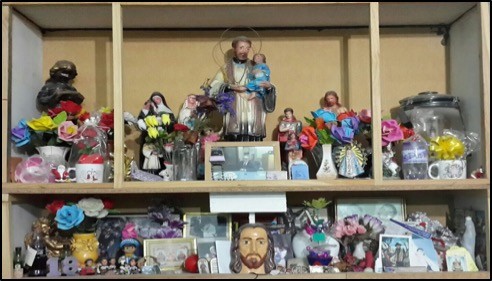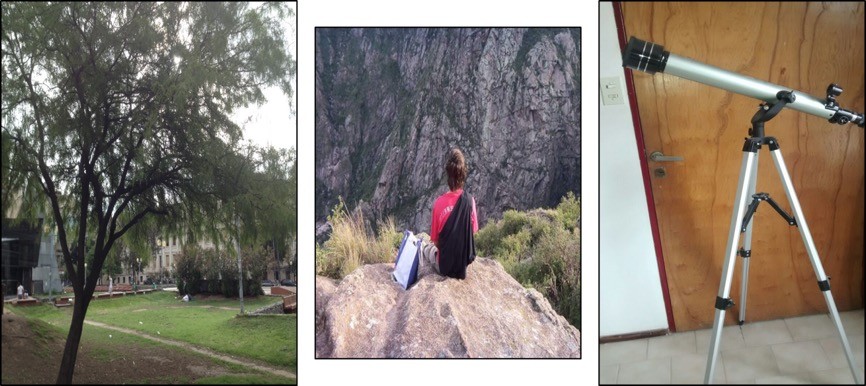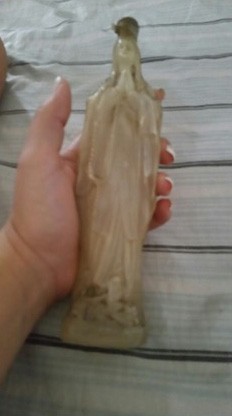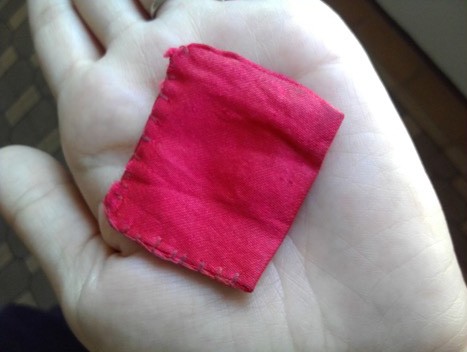Stories

Lucy || Católica || Nivel socioeconómico bajo
“El altar de Lucy es sumamente complejo y en él hay lugar para todo. Está en el living de su casa y para ella es algo “inexplicable” y significa muchas cosas: “paz, felicidad, amor, cariño, esfuerzo”. Fue construido por su marido, “todo a mano”. Quedó levemente inconcluso y ella dice que “ya lo voy a terminar yo”. Resta por hacerle algunos detalles (vidrios, por ejemplo). En él hay fotos familiares (esposo, suegra) y de personas importantes; una placa de la cremación de su suegra y las cenizas de su marido; diversos santos representados y objetos religiosos (San Cayetano, la Virgen de Lourdes, el Sagrado Corazón de Jesús, San Expedito, Santa Rita, entre otros); distintos souvenirs. Incluso hay objetos que ella dice no saber qué significan (un Ángel negro, por ejemplo, ella dice “No sé porque negro, porque a mí esposo le
gustaba”).
En el wallpaper de su teléfono celular tiene la imagen de su altar. Es decir, que lo lleva consigo a cada momento. También en su trabajo cuenta con imágenes y objetos que representan mucho para ella y que derivan de distintos campos, no sólo del religioso.”
Lucy || Catholic || Low Socioeconomic Status
“Lucy’s altar is extraordinarily complex and in it there is a place for everything. It is in the living room of her house and for her is something she can’t fully explain since signifies many things: ‘peace, happiness, love, caring, strength’. It was built by her husband, ‘completely by hand’. It remained slightly unfinished and she says that ‘I will finish it’. Small details remain to be done (glass, for example).
In it there are photos of family (husband, mother-in- law) and of people important for her; a plaque from the cremation of her mother-in- law and the ashes of her husband; various Saints are represented and religious objects (San Cayetano, the Virgin on Lourdes, the Sacred Heart of Jesus, San Expedito, Santa Rita, among others); distinct souvenirs. There are even
objects that she says she does not know what they signify (a black angel, for example, she says ‘I do not know why black, because my husband liked it’).
In the “wallpaper” (background) of her cell phone she has a picture of her altar. That is to say, she carries it with her in every moment. Also in her work she has images and objects that represent a lot for her, and that come from different fields, no only the religious.”
Abraham || Evangélico || Nivel Socioeconómico Bajo
“Este participante ha presentado una fotografía propia junto a una ex novia que quedó en su país de origen, Perú. Este objeto muestra cualidades de amuleto: “algo que me dio fuerzas desde que llegué. Es una foto de la primera chica con la que estuve saliendo allá (Perú)”. Es una foto que la ve “constantemente, […] Para verla siempre para pensar para recordar” y la tiene presente en cada momento. Esta fotografía es el objeto en el que más pensó para mostrarnos en su entrevista, el que “más sentí fue ésta foto, es lo más representativo”.
En la historia de vida de Abraham uno de los hitos más importantes fue haber dejado su país e ir a vivir a la Argentina. Este objeto le sirve como “recuerdo de ella que cada vez que la veo siempre fue… me da ánimo, me hacía acordar muchas cosas buenas, que yo podía progresar, que sí podía hacer las cosas, que las personas pueden cambiar. Fue bastante ayuda para mí” y le ha servido para vivir lejos de sus afectos más cercanos.
En la parte posterior de la fotografía está la dedicatoria de su ex novia: ‘Aquí con mi angelito precioso nada más y nada menos que en el recuento de promociones del Colegio de Ingeniería en compañía de una gran orquesta, Méndez…’ “
Abraham || Evangelical || Low Socioeconomic Status
“This participant has presented a photograph of his, together with an ex-girlfriend that stayed in his country of origin, Peru. This object demonstrates qualities of an amulet ‘something that gives me strength from where I come, it is a photo of the first girl that I was going out with (dating) there (Peru)’. It is a photo that he looks at ‘constantly, […] To look at it is always to think in order to remember’ and he has it present in every moment. This photograph is the object that he thought of most to show us during his interview, that which ‘I felt most was this photo, it is the most representative’.
In the story of the life of Abraham on of the most important milestones was to have left his country and go to live in Argentina. This object serves him as a ‘remembrance of her that every time I see always was… giving me encouragment, making me remember many good things, that I could progress, that if I could do things, that people can change. It was of great help to me’ and it has helped him to live far from his closest affections.
On the back of the photograph is the dedication of his ex-girlfriend: ‘Here with my precious little angel nothing more and nothing less than the remembering of our class in the College of Engineering in the company of a great orchestra, Méndez”.

Ezequiel || Ateo || Nivel socioeconómico Medio-Alto
Ezequiel se define como "nuevo ateo". Es un joven médico que trabaja como médico en un servicio de emergencias y realiza un doctorado en ciencias biológicas. En su familia, su madre pertenece a un culto New Age, es vegetariana y no vacunó a sus hijos, creencias y prácticas que él heredó y sostuvo durante toda su carrera pero una vez finalizado, comenzó a vincularse con círculos escépticos, leyó textos de Sagan y papers científicos que lo llevaron a cuestionar toda pseudociencia y creencia de tipo espiritual no basada en evidencias. Muy crítico de la
homeopatía, de la injerencia de las religiones en el espacio público y de la toma de decisiones que no se basan en evidencia científica.
Ha elegido como objetos significativos un telescopio, el Internet y una plaza que connota la naturaleza. Esta serie de objetos elegidos guarda fuerte relación con lo contado en la entrevista y su historia de vida.
Estos objetos tienen que ver con “el sentimiento de espiritualidad. Para mí no hay un podio, van los tres por igual”. Ezequiel dice tener momentos de trascendencia asociados con la admiración de la naturaleza y el universo, y el ejercicio físico.
Todos los objetos elegidos por Ezequiel apuntan hacia lo mismo: la cientificidad, el conocimiento basado en la evidencia y la completud con la naturaleza y sus reglas biológicas y químicas.
Así, Internet “es una fuente de información que te puede llevar al libre pensamiento” y la naturaleza y el telescopio exhiben que él “no me considero un ser aparte de la naturaleza. Estamos regidos bajo las mismas leyes biológicas, físicas, químicas.”
Ezequiel || Athiest || Upper-Middle Socioeconomic Status
Ezequiel defines himself as a “new atheist”. He is a young doctor that works as a doctor in emergency services, and became a doctor in biological sciences. En his family, his mother belongs to a New Age cult, she is vegetarian and did not vaccinate her children, beliefs and practices that he inherited and maintained throughout his career but at one point ended, he began to be linked to skeptical circles, read books of Sagan and scientific papers that led him to question all pseudoscience and beliefs of a spiritual type not based in evidence. Very critical of homeopath, of the interference of religion in the public sphere and decision making that is not based in scientific evidence.
He has selected as significant objects a telescope, the internet, and a plaza that connotes nature. This series of chosen objects is strongly related to what he said in his interview and his life story.
These objects have to do with “the feeling of spirituality. For me there is no winner, the three are equal.” Ezequiel claims to have moments of transcendence associated with admiration of nature and the universe, and physical exercise.
All of the objects chosen by Ezequiel point to the same thing: the scientific, knowledge based in evidence, and the completeness with nature and its biological and chemical rules.
So, Internet “is a font of information that can lead you to free thought” and nature and the telescope exhibit that he “I do not consider myself to be apart from nature. We are governed under the same biological, physical, and chemical laws.

Noelia || Creyente sin Iglesia || Nivel socioeconómico medio
“Tengo un objeto de valor, que es una virgen, en realidad, pero no por la virgen sino por lo que significaba, que era de mi abuela. Esa es una virgen, la virgen del Verdún, tiene agua bendita adentro, de hace muchos años, mi abuela falleció cuando era chica. Y... ta, la virgen mismo, en realidad es como que me refugio cuando estoy, o sea, es un objeto que para mí es sumamente preciado. Y uso esa agua solamente cuando estoy en un momento realmente duro, como que no veo salida, como que tengo mucha fe en eso, en la virgen, en el agua que tiene adentro. Pero es más por mi abuela, por la fe que le tengo a ella que por lo que es la virgencita.”
Noelia || Believer without Church || Mid-Level Socioeconomic Status
“I have one object of value, which is a Virgin, in fact, but not because it is a virgin but for what it meant, it was my grandmother’s. This is a Virgin, the Virgin of Verdún, it has holy water inside, from many years ago, my grandmother passed away when I was a girl. And… mmm, the same virgin, in fact is what shelters me when I am, that is, it is an object which, for me, is extremely precious. And I use the water only when I am in a very difficult moment, like when I do not see an exit, like I have much faith in that, the virgin, the water inside. But it is more because of my grandmother, because of the faith I have in her through the virgin.”

Pablo || Ateo || Nivel socioeconómico medio
“El objeto es una pipa que tiene la forma de la cabeza de un anciano y tiene alrededor de 100 años. Era la pipa de mi tatara - tatarabuelo, que fue el primero de mi familia en venir para Uruguay desde Argentina. Él (el tátara- tatarabuelo) era capitán de un barco mercante que vino a Uruguay con la esposa embarazada. Estaba comerciando acá y en esa época hubo una guerra (no me acuerdo cuál) y en uno los viajes que hacía por esta zona, unos mercenarios se subieron al barco y lo mataron. Él se quedó en Buenos Aires esperando que la mujer tuviera al hijo para empezar a navegar y fue a los pocos meses de que hubiera nacido el hijo. La mujer también
murió por esa época no sé muy bien de qué pero se quedó el niño solo. Esta pipa le llegó a la familia varias décadas después, tanto que ni siquiera le llegó a mi tatarabuelo (el hijo del capitán) sino que le llegó a mi bisabuelo en un baúl. Para mí es importante, sobre todo ahora porque esta pipa era lo único que teníamos de nuestra familia. A partir de esto me siento más conectado con la historia de mi familia y esta pipa es como lo que simboliza eso.”
Pable || Athiest || Mid-level Socioeconomic Status
“The object is a pipe shaped like the head of an old man and it is close to 100 years old. It was my great-great grandfather’s pipe- my great-great grandfather, who was the first of my family to come to Uruguay from Argentina. He (my great-great- grandfather) was captain of a merchant ship and who came from Uruguay with his pregnant wife. He was doing business here and in that time there was a war (I do not remember which) and on one of the trips that he made in the area, some mercenaries boarded the ship and killed him. He stayed in Buenos Aires waiting for the woman to have the baby in order to start to sail and it was only a few months from then when the baby was born. The woman also died during that time, I do not really know well from what, but the child was alone. This pipe came to family several decades later, so much later that it did not reach the captain’s son, but it came to my great-grandfather in a trunk. For me it is important, above all now because this pipe is the one thing that we had of our family. Apart from that I feel more connected with the story of my family and this pipe is what symbolizes that.”

Germán || Católico || Nivel socioeconómico bajo
“Esto está en mi billetera, que siempre la tengo, que es una simpatía de mi abuela, que en paz descanse, que tiene dos crucecitas adentro, es rojo, esta cocido… que es más bien de creencia de viejo antiguo que te decían que era para que no te falte el dinero, o la envidia. Son dos crucecitas que están ahí, cocidas en una cinta, que pasó de mi abuela a mi madre y mi madre me lo obsequió… y ta, yo tendría la obligación… no a mi hijo pero si tengo algún familiar cercano… Me gustaría, por lo menos que quede… de generación en generación… Lo único que se cambia es la cintita… son dos crucecitas como si fuera, caravanas o fantasía, que como creyente católico me quedó. “
Germán || Catholic || Low Socioeconomic Status
“This is my wallet, which I always have, it is a good-luck charm of my grandmother, may she rest in peace, which has two little crosses inside, it is red, it is sewed… which is a rather old-fashioned belief that they told you so that you did not lack money, or envy. There are two little crosses that are there, sewed in a ribbon, which passed from my grandmother to my mother and
my mother gave it to me… and ta, I would have the obligation… not to my son, but if I have a close family member… I would like, at least for the little that remains… from generation to generation… The only thing that changes is the ribbon… they are two little crosses almost as if it were, caravans or fantasy, that I was left with as a Catholic believer.

